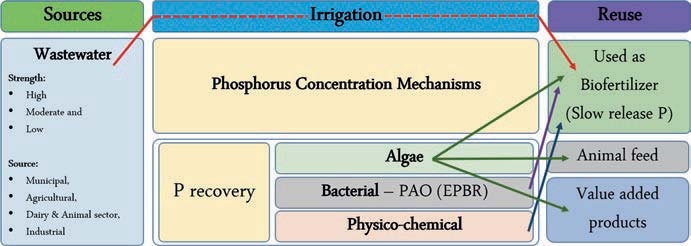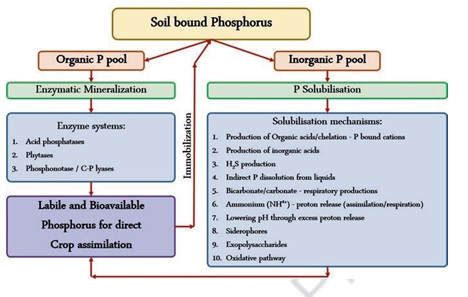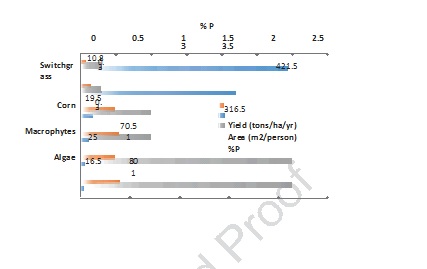|
1.1 Introduction
P is crucial in crop development and growth, comprising of ~0.2% of crop plants dry weight. After nitrogen, it is the second most important nutrient limiting the crop growth (Kvakic et al. 2018). Although 0.5 kg P/ton of agricultural soil is naturally found, but only 0.5 g of soil bound P is actually available for plant uptake. Conventional agricultural practices have minimized the inadequacy of the P in soils through external application of P rich fertilizer. Such practices over decades has resulted in environmental externalities as nutrient enrichments in surface and ground waters (Bauke et al. 2018). This necessitates identification of potential alternatives to chemically fixed synthetic fertilizer and explore possible microbial immobilization and channeling strategies for a sustainable agriculture. Microbiota is soils perform nutrient mineralization and thus aid in nutrient assimilation in crops. They are mainly involved in breaking down complex insoluble organic/inorganic forms into simpler ions through solubilization/mineralization (Menezes-Blackburn et al. 2017). An array of pedosphere microbiota associated with the rhizosphere are generally known for P mineralization, solubilisation and mobilization in plants (Turner et al. 2015) and are refereed at P solubilizing microbes(PSM). Some stress tolerant microbes as halophiles also aid in solubilizing P from alkaline soils (Sharma et al. 2013). Propagating such suitable and select microbes are smart ways for soil nutrient enrichment that directly evades the risks of application of costly chemical fertilizers and restricts environmental damages (Nath et al. 2017).

Fig. 1.1 Various mechanisms of P recovery from wastewater with emphasis on algal route
Capturing nutrients from wastewaters through its direct application or through temporary immobilization through beneficial algal communities are attractive solutions for closing the phosphorus cycle ensuring reusability and ecological gains (Sharma et al. 2013). Wastewaters could be potential nutrient hubs for agricultural food security. However, there can be several constraints in its utility (a) quality concerns (pathogens/toxins) (b) time for storage and preserve the nature of the dissolved nutrients as crops have seasonality (c) transportation to various agricultural locations (for applications of 1 ton of P around 150 kilotons of wastewater is required).Wastewater as potential P sources albeit effective are however challenging in terms of treatment, storage and transportation costs (Shilton et al. 2012). If, the irrigational requirements are met, a suitable way for nutrients applications to agricultural crops is through temporary immobilization of dissolved forms in the form of algal biomass. This nutrient rich algal biomass can be directly applied to these croplands and potentially acts like slow release fertilizer as elucidated in Fig. 1.1. P recovery from wastewaters have been carried out through adsorption based processes, precipitation and bacterial process in enhanced biological phosphorus removal (EBPR) and have been explained in earlier studies (Pratt et al. 2012; Yuan et al. 2012). Algae owing to high ubiquity tolerance, faster growth rates and adaptations (Christenson and Sims 2011) have been recently witnessed as a most attractive biological agent for capturing nutrients as phosphates provides a huge scope for sustainable technology development for harnessing nutrients.
1.2 Microbial Phosphorus Immobilization
Microbiota in soil systems as cyanobacteria, bacteria and fungi with other soil organisms help in efficient nutrient cycling of P through mineralization and P immobilization (Barea and Richardson 2015). P mobilization from organic and76 inorganic P pools are carried out through enzymatic mineralization and insoluble Psolubilisation respectively through various mechanisms i.e. carboxylates, phosphatases; exuding protons to release inorganic labile phosphates (Sharma et al. 2013)as provided in Fig. 1.2. PSM are groups of microbes comprising of bacterial members as Agrobacterium sp., Bacillus sp., Erwinia sp., Flavobacterium sp., Micrococcus sp., Pseudomonas sp., Rhizobium sp. and fungal members as Aspergillus sp., Penicillium sp. and Trichoderma sp. (Sharma et al. 2013; Srinivas et al. 2012). In some cases the available P in soil systems are uptaken by soil microbes and becomes a part on microbial biomass phosphorus. Such condition facilitates rapid organic C uptake of root exudates for meeting the energy requirements (Wu et al. 2007). Phosphorus that is trapped in the microbial biomass often gets released back into the soil available P pool during microbial genesis and is dependent on the environmental conditions as soil nutrient pool, seasonality and soil moisture (Butterly et al. 2009). Estimates have shown that influx of P from microbial biomass P pools can range from 18 to 36 kg P/ha/season especially during summer and fall (Liebisch et al. 2014).

Fig. 1.2 Schematics of P transfer routes in agricultural soil systems through mineralization and solubilisation
The P availability is dependent on the relative concentration of P pools in soil systems and the microbial biomass P. In highly bioavailable soil P conditions, usually the microbial biomass P have been found to be low (Marschner 2008). These dynamics are governed largely by a number of factors as the soil carbon to phosphorus ratio (Spohn and Widdig 2017). At squat C:P levels, microbial P pools are low(Kouno et al. 2002); attributed to C limitations and moreover, the microbial P pools increase with increase in C:P ratio (Cleveland and Liptzin 2007). Over the years with applications of enriched P based fertilizers, there has been a decline in the C:P ratio, that demands an increase in the C:P ratio so that substantial amount of P can be immobilized back into the microbial biomass P pools (Xu et al. 2015). Investigations on sol P dynamics have witnessed a lower microbial biomass P pool in intensive agricultural zones (Oberholzer et al. 2014) compared to forest and grassland ecosystems (lower C:P ratio) attributed to removal of C rich above ground biomass (Bender et al. 2016). Thus, provisions for additional C supplementation into the soil would help in better P immobilization in such systems. Addition of Crich plant residue or organic amendments can increase the microbially fixed biomass P phenomenally.
One of the major measures for enhancing the C content of the soil is by the application of wastewater grown algal biomass that not only provides nutrients as P to the soil systems but also improves the soil C that is required for higher microbial diversity and P pools (Mahapatra et al. 2017). Such algal biomass can be grown from a variety of wastewaters as diary, municipal or agricultural i.e. nursery wastewaters.Our recent studies on alga grown on leachate (Naveen et al. 2016; Karthik et al.2018); high strength flushed manure wastewater and municipal wastewaters (unpublished data) have shown higher algal productivity with enhanced nutrients capture. This algal biomass can be utilized both as biofertilizer as well as for improving the C:P ratio in the soil for ensuring higher microbial biomass P pools, that helps in the improving the nutrients status of the soils and its long term sustainability in agricultural food production. Moreover, the algal biomass can be also mixed with other agricultural residues for a resilient and vibrant phosphorus economy and biorefinery. This approach helps in developing circular bio economy and dramatically reduces the nutrient loads on the environment. However, it will be interesting to note the mechanisms of C mobilization after its land applications and potential mineralization and associated emissions from the soil and its implications on the availability of other essential minerals to the plants. Moreover, any possible changes in the soil microbiota can also be beneficial for the complex agricultural systems and over a period might enhance the diversity of microbes for a green and sustainable agricultural future.
1.2.1 Algae Mediated P Immobilization and Channelization
Algae are cosmopolitan and have been now largely known for its effectiveness in treating wastewaters of various strengths and from diverse sources globally (Park et al. 2011). Mostly, they have been used through conventional facultative ponds, high rate algal ponds (HRAP) and tubular photobioreactors (Abis and Mara 2003; Craggs et al. 2014). However, in such systems phosphorus removal and recovery have not been specifically undertaken (Garcia et al. 2000). The conventional facultative ponds/lagoons are highly effective in reducing the nutrient loads through efficient nutrient capture and have resulted in substantial pathogen reduction. These facultative ponds systems have not been capitalized for targeting nutrient rich biomass cultivation and subsequent harvest. On, the other hand HRAP’s are being used for mass scale production of algal biomass and thus can be optimized for higher productivities and bioproducts yields (Craggs et al. 2011). This is performed through various manipulations in (a) micro-environmental and physico-chemical factors (inorganic C additions, low pH conditions) (b) reactor design and configuration (provisions for effective mixing, enhancing mass transfer, shallow reactor depths and shorter residence times). More often it has been observed that the P content of wastewater algae are comparatively high due to the phenomenon of luxury P uptake (Shilton et al. 2012). The P content in wastewater algae can be as high as 3.3% (Powell et al. 2008) compared to ~0.5 to 1%, typically observed in algal biomass. These observations have been also confirmed through our earlier studies with mixo- trophic algal unialgal and co-cultures (Mahapatra et al. 2013a, 2014; Mahapatra 2015) cultivated with municipal wastewaters and have been witnessed in other stud- ies as well (Powell et al. 2008).

Fig. 1.3 Bar chart indicating comparative area requirement, yields with
P quantity in agricultural substrates (switch grass and corn); Macrophytes and Algae with nominal P content
(~1%) and Macrophytes and Algae with high P content (3%, luxury P uptake)
It has been shown that the luxury P uptake in case of these algal communities directly depends upon, the temperature, light intensity and inorganic P concentra- tions in the growth media (Fanta et al. 2010; Cade-Menun and Paytan 2010; Sforza et al. 2018). Possibilities of concentrating phosphorus in P rich (~3% of the bio- mass by weight) algal biomass are in progress, and can potentially reduce the area requirements in P recovery via HRAP to 5.5 m2/capita (Fig. 1.3). This dramatically reduces the costs for harvesting, conveying and spreading it on agricultural land as biofertilizer by factor of 0.6 as compared to usual algae/organic substrates with P content <1%. On one hand, the facultative ponds have their own advantages in treatment and harbor beneficial motile flagellate algal communities i.e. Euglena spp. and Chlamydomonas (Mahapatra 2015) and non-motile algae as Chlorella and Chlorococcum (Mahapatra et al. 2013b, 2018; Mahapatra and Ramachandra 2013). On the other hand, ongoing innovations in multimodal algal bioprocess design have been targeting various strategies for efficient harvesting i.e. gravity based, flocculants, and other polymer-mediated methods (unpublished data). There have been studies that have proved efficient harvest with the help algal cells immobilized as beads made up of alginate, carrageenan and chitosan, (De-Bashan and Bashan 2004) for efficient P recovery. The immobilization media also facilities P retention through adsorption and precipitation (De-Bashan et al. 2004). Studies have revealed >90% P removal with chitosan immobilized Scenedesmus (Fierro et al. 2008). Recently algal turf scrubbers with the immobilized attached algal community’s grown as biofilm communities over various kinds of surface are being used for treatment of dairy (Pizarro et al. 2006; Mulbry et al. 2008; Prabakar et al. 2018), agricultural (Kangas and Mulbry 2014) and swine facility wastewater (Kebede-Westhead et al. 2006).
Algal derived phosphorus can be highly valued resource under today’s regime of nutrient scarcity. Globally voluminous wastewater discharge enriches large surface water resources. These water resources can be filtered from nutrient through algal technologies and can be directly applied as slow release fertilizers into the agricultural areas that ensures a biorefinery approach thereby completely closing the nutrient cycles. The typical architecture of a facultative ponds and lagoons especially in tropical waters have multi-tier algal communities that help in efficient nutrient remediation, and wastewater purification (Mahapatra et al. 2011a, b, c; Chanakya et al. 2012, 2013; Mahapatra 2015; Mahapatra et al. 2017). The experiments on algal cultivation with high strength wastewater i.e. municipal wastewaters have demonstrated higher nutrient recovery and biomass productivity with high P concentrations in unialgal and polycultures especially with the mixotrophic community (Mahapatra et al. 2013a, b, c, d, e, f, 2014, 2017). Wastewater treatment systems involving facultative ponds have shown a higher techno-economic feasibility for algal single cell proteins i.e. euglenoides (Mahapatra et al. 2016) and as biofertilizer as Spirulina sp. (Mahapatra et al. 2018) with a lower environmental impact (Ramachandra and Mahapatra 2015; Ramachandra et al. 2015). A modular algal bioprocess designed at the Indian Institute of Science (IISc), Bangalore, have been successfully working for nutrient capture and recovery at the Jakkur Lake in Bangalore City (Ramachandra et al. 2014; Mahapatra 2015).
| Citation: |
| |
D. M. Mahapatra, R. Mahapatra, L. Singh, H. J. Kadhum, G. S. Murthy, H. N. Chanakya, N. V. Joshi, Ramachandra. T.V.,2019. Phosphorus Capture, Immobilization and Channeling Through Algae for a Sustainable Agriculture. © Springer Nature Singapore Pte Ltd. 2019 D. G. Panpatte, Y. K. Jhala (eds.), Soil Fertility Management for Sustainable Development, https://doi.org/10.1007/978-981-13-5904-0_1
|
| * Corresponding Author : |
| |
Dr. T.V. Ramachandra
Energy & Wetlands Research Group, Centre for Ecological Sciences, Indian Institute of Science, Bangalore – 560 012, INDIA. |
|
Tel : 91-80-23600985 / 22932506 / 22933099,
Fax : 91-80-23601428 / 23600085 / 23600683 [CES-TVR]
E-mail : emram.ces@courses.iisc.ac.in, energy@ces.iisc.ac.in,
Web : http://wgbis.ces.iisc.ac.in/energy |
|